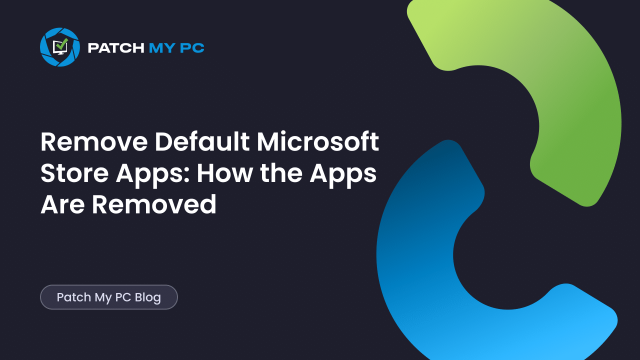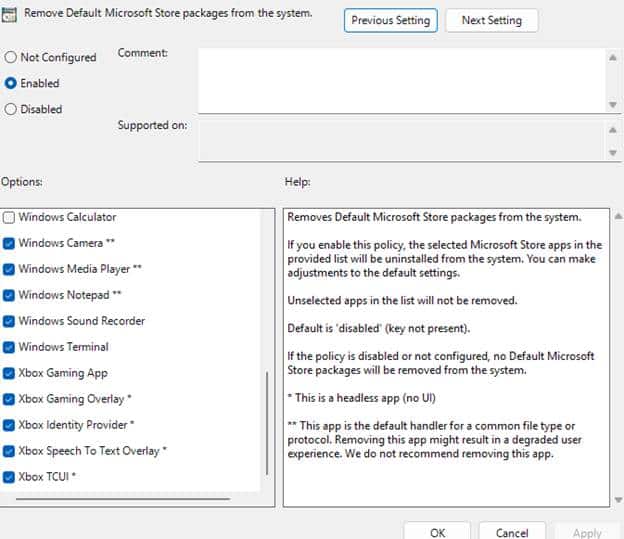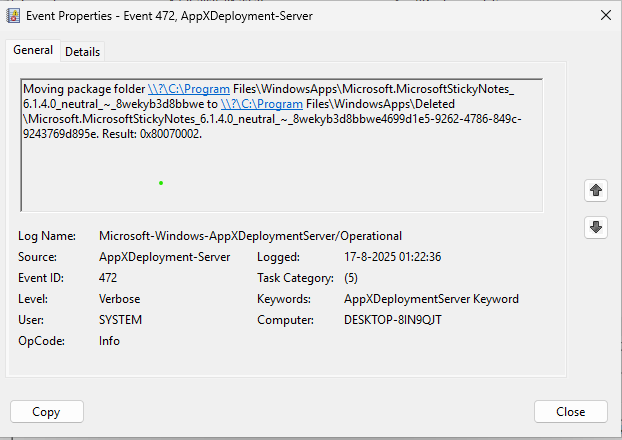
This blog will be about what actually happens when you enable the new “Remove Default Microsoft Store Packages” and how this policy ensures that those Microsoft Store Apps are removed from the system!.
Introduction
In the previous blog, we looked at the new “Remove Default Microsoft Store Packages from the System” setting in Windows 11 25H2.

At first glance, it looks like a simple provisioning blocker. But in practice, it goes further. When enabled, the policy:
- Removes the Microsoft Store apps for all users on the device (after their next logoff/logon)
- Blocks those apps from being provisioned again for any new user
So instead of just blocking future installs, it also actively cleans out what’s already there.
How the “Remove Default Microsoft Store Apps” policy works
After being poked by Vincent on LinkedIn (asking what really happens when this policy is activated), we became intrigued and took another deep dive into AppxAllUserStore.dll, the component behind the provisioning logic. To do so, we used the IDA tool. If you want to learn more about this, check out our YouTube deep dive
Using the IDA tool, as we showed in the YouTube video above, we spotted the function: AppxAllUserStore::CleanupPackageFromPerMachineStore

This function clearly moves package files out of the normal provisioning path. Specifically:
- App package folders in: C:\Program Files\WindowsApps are moved to: C:\Program Files\WindowsApps\DeletedAllUserPackages

When looking at the device itself, it indeed showed us the same flow. After the user signed in, all the app store packages were moved to the DeletedAllUserPackages:

- From there on, the flow also deleted (moved) the corresponding registry entries in: HKLM\SOFTWARE\Microsoft\Windows\CurrentVersion\Appx\AppxAllUserStore\Applications

are moved to: HKLM\SOFTWARE\Microsoft\Windows\CurrentVersion\Appx\AppxAllUserStore\Deleted\Applications

That’s it. This ensures that all selected Microsoft Store App Packages are removed from the system.
We Replicated It Ourselves
Just to be sure, we wrote a PowerShell script to do exactly what the function does:
- Move every folder inside C:\Program Files\WindowsApps to a DeletedAllUserPackages folder (except the Deleted folder itself)
- Move each corresponding registry key into a new Deleted subkey

It worked. No more provisioning of the Microsoft Store Apps. New users logging in didn’t get the apps. And no errors either. It matched Microsoft’s behavior one-to-one.
Existing Users? That seems to work too!
Once you have applied this policy to existing users, they only need to log off and on again to ensure those Microsoft Store Apps are removed. Check out the video below!
As shown in the video, after selecting the Sticky Notes Microsoft Store App as one of the apps that needs to be removed, after logging off and on, the app is gone!
Final Thoughts
This new Store App policy is a massive improvement over the old “debloat” hacks. It removes inbox apps for all users at the next sign-out/sign-in, prevents provisioning for new users, and does it cleanly without messy scripts or Autopilot race conditions.
Microsoft has finally provided a reliable method for removing the built-in Store apps. For everything else, third-party software that requires deployment and ongoing updates, Patch My PC takes over. Book a demo to see how we simplify app management beyond the Microsoft defaults.



